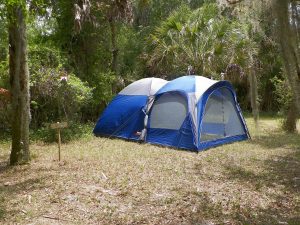Regular camping is a great way to rewind and relax after weeks or even months of tight schedules and family responsibilities. At less fortunate times, you may have to camp in the wilderness following a disaster.
In both cases, your chances of survival depend on the site where you camp. You’ll often find yourself camping in the wilderness or bush. Poor choice of a campsite could be a recipe for disaster. A bad campground exposes you to strong wind, too cold or hot temperature, dampness, and wetness, surface runoff or even the danger of attack.
In this article, we are going to discuss the most critical factors worth considering elements to choose an ideal campsite. Our points of focus include shelter, drainage, and exposure to the elements, danger from surface runoffs and falling materials, access to primary resources, and more.
1. Shelter from Extreme Weather Conditions

You might have escaped the initial disaster that drove you out of your home. But, your chances of survival may reduce tremendously if you are not sheltered from the inclement weather.
The first thing is to have a way to shelter yourself from extreme conditions such as the rain, hail, snow, sleet, dust, wind and sandstorms, and more. A camping tent is the best shelter, but it may be too bulky and heavy to carry. Nevertheless, you can build a shelter such as a lean-to, wickiup, survival hut, tarp shelter, spider shelter, snow cave, igloo and many more.
Even if you have the best shelter, it may prove useless if you do build it in a protected area. Tight groves of trees are magnificent in slowing and stopping the wind. They can also protect the shelter from the direct effects of torrential rainfall. The same goes for cliffs, hollows, hillsides, shrubs, embankments as well as other obstacles.
2. Drainage
Drainage is another vital factor worth considering into choosing a campsite. Surface runoff from rains can cause floods. The same goes for which can then gather and travel in the direction of slopes on the landscape.
If you set your camp on the path of such flood waters, the water can come when you least expect it and carry you and your stuff away. The problem is that the most level areas in the wilderness are usually just below slopes. You must be careful of drainage when you are choosing the spot to set your tent or build your shelter.
Apart from avoiding food paths, you also need to stay away in poorly drained areas such as swaps. Such places are often breeding grounds for deadly insects such as mosquitoes. Furthermore, poor drainage may damage your survival gear.
3. Sun Exposure
Sometimes the sun is suitable for bathing especially if the temperatures are moderately hot. In hot conditions, sunburn becomes a serious concern. In this case, the site you choose to set your tent should be shielded from direct sunlight.
Choose a place with numerous obstacles that block sun rays. Examples include tree grooves, rock cliffs, bluffs, shrubs as well as other natural features. In a desert, the stakes are even higher. You may need to build a shade if you must remain protected from severe sunburn.
4. Falling Materials or Snags
Since you need to set camp in a shielded area, you will also need to beware of snags and falling materials. You cannot risk having these objects falling on you while you are sleeping in your tent. Another prime consideration when choosing a campsite is to avoid danger from things falling on you.
The most important source of the threat is dead trees called snags or dead tree branches on living trees (called widow makers). Other possible sources can include shedding rocks from cliff faces, landslides or mudslides, and avalanches.
If the winds are strong and high, snags and widow makers can fall without first warning you. At times, such objects may fall even without any wind at all. So, you will do better by situation your campsite away from such threats. It will shock you how many people die from falling objects when they are camping.
5. Temperature
Learning about temperatures variations can be lifesaving. You need the information before you can set your camp. Generally, warm air is lighter, and therefore it will rise. Cold air, on the other hand, is denser and so will remain closer to the ground.
If you are in a cold environment, set your camp toward the top of the hills to take advantage of the warm air masses. Be careful to avoid exposed areas and ridges where the wind can lower the temperatures even the more.
In hot conditions, it would be best to set your camp at the foot of a hill where cold temperatures exist. You can also set it up near ridges or partly exposed areas of the mountain to take advantage of the evening breeze.
6. Water Access
Water is life. Without it, you can only survive a few days. The time is even less if the weather conditions are hot. Therefore, access to water is essential when choosing a good campsite.
You will need water for drinking (hydration) hygiene and cooking. Water may also help you put out a fire that gets out of control. If possible, locate your camp just a few feet from a water source.
But this could be a double-edged sword because water attracts wild animals. It would be good to set it where you are sure your presence will not interfere with the wild animals when they need to come to the water point and drink. You can also make a fire pit to scare them away. You also need to watch out for the possibility of flooding.
7. Food Access
You can only perform optimally both physically and mentally if you obtain enough calories daily. This is why your camp should be as close to food sources as possible.
Sometimes, you may want to go out and forage, hunt or fish for food. Situating your campsite near the food source means you will not go too far from your camp. This will limit your chances of drifting away and getting lost in the wilderness. Food access is even more critical if you plan on long-term survival.
8. Firewood Access
Fire is crucial to survival in outdoor emergencies. You will use it to cook food, stay warm, purify water, dry out, and to scare wild animals away. At times it can serve as a signaling tool.
For the fire to burn continuously, you will need a reliable source of fuel. What comes to mind in the wilderness is firewood. Therefore, a source of wood is essential when choosing the best site for a camp. The firewood ought to be dry, abundant, comfortable to gather and conveniently sized. An excellent alternative to wood is dried dung. Learn more how to split firewood.
Conclusion
If you can meet these conditions, nothing will stop you from enjoying a great time in the camp or having a successful survival episode. There might be other factors to consider, but these eight are the most important. Talk to any experience survivor, and he or she will confirm this list.
